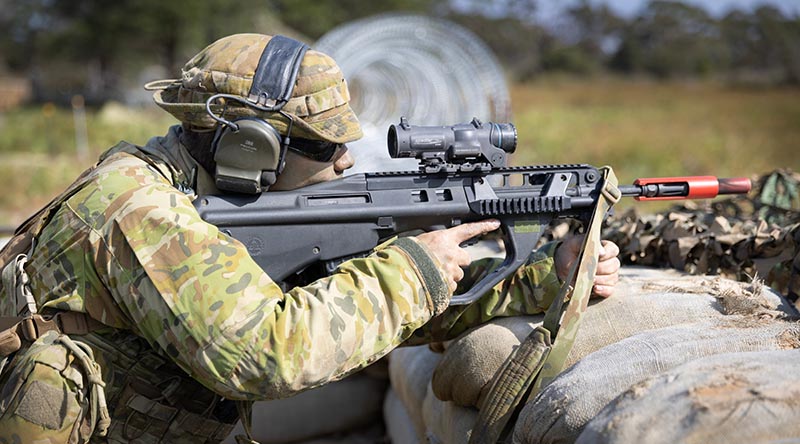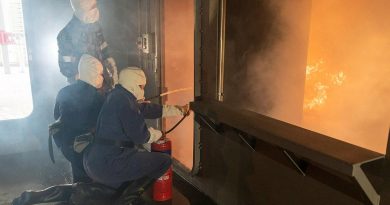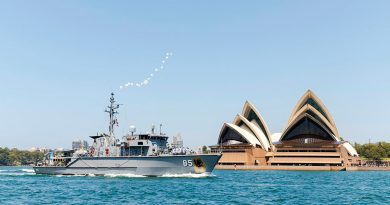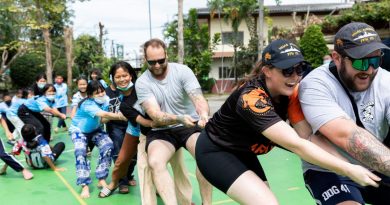Major changes to RAAF officer training

As an air-raid siren rings out and a simulated grenade explodes, officer trainees open fire to defend an imitation air base.
CAPTION: A Royal Australian Air Force officer trainee takes part in the field phase of the officer training course at Dutson Air Weapons Rangel, East Sale. Photo by Private Nicholas Marquis.
Five hundred kilometres north, recruits climb ropes, mount walls and crawl through tunnels as they navigate a confidence course.
Having been gassed, fatigued and kept up at night by ‘enemy’ attacks, graduation is in sight for the first groups of officers and recruits undertaking their respective consolidated initial training courses.
This is part of a less-is-more approach to initial training that has seen 1 Recruit Training Unit (1RTU) reduce their course from 11 weeks to nine and Officer Training School from 17 to 14 and eventually 12 weeks.
It follows Air Commander Australia identifying a need to grow the Royal Australian Air Force faster, by graduating trainees quicker and more efficiently.
One big change at 1RTU is tightening training blocks to make the ‘green phase’ a three-week continuous period.
Airfield defence guard Corporal Ricky Watson said compression of the course allowed the ground defence element to have more time with trainees, instead of splitting their time into different blocks.
“We used to waste time signing weapons in and out and going through revision of topics we covered in previous weeks,” Corporal Watson said.
“Now it’s weapons, range, CBRN (chemical, biological, radiological and nuclear) and ground defence.
“We’re able to get a lot more out of it knowing we don’t have to revisit things later on course, and they are more focused.”
Corporal Watson said this year’s introduction of range practices was also improving their skills in combat shooting.
Flight Sergeant Sean Seery, of OTS, said aviators now have a better understanding of operating in difficult environments with the inclusion of the combat marksmanship continuum.
“When it comes to ground combat, aviators generally operate in a close-defence area,” Flight Sergeant Seery said.
“Previously, we would take trainees to the range, they would lie down, get comfortable and shoot.
“Now they are shown how to run their weapon in many different positions, employing it using combat behaviours and new shooting techniques.”
Officer trainees are also temporarily issued Australian multicam camouflage uniforms to help instil a warfighter attitude during their field phase.
Executive Officer 1RTU Squadron Leader Matt Kelly said the new training approach removed inefficiency while consolidating blue and green phases.
“We introduce them to the fundamentals and gradually increase the tempo to the point where they have the skills they need to enter our workforce,” Squadron Leader Kelly said.
“We’re now thinking very clearly about what training outcomes the Royal Australian Air Force needs in preparing for operations in our region and are designing a product to align with that.”
The shortened course means 1RTU can run additional sessions throughout the year with less overlap, expanding the capacity of each individual session.
This increased 1RTU capacity by 85 per cent compared to the number of recruits trained in 2022.
Commanding Officer OTS Wing Commander Garth Herriot said the content hadn’t significantly changed, but had been refined and distilled.
“We have cut out the bits of fat within the program,” Wing Commander Herriot said.
“The learning outcomes that we deliver largely remain the same and, if not, we have modified them to meet contemporary requirements.
“We used to hop on a bus and drive for a few hours for adventure training, whereas now we now have a brand new abseiling tower on site.”
He said there were always going to be risk with such changes, but it was about accepting that risk and training to deliver an outcome.
“We might have to do less physical training, but we are able to graduate someone faster for the Royal Australian Air Force,” Wing Commander Herriot said.
“We identified training duplication within the course and removed the inefficiencies, but we are still graduating our trainees at a high level.”
.
.

.
.






I was in the RAAF for about 17 years Proud to have done so But I reckon 3 weeks of the recruits course 1RTU not OTS was purely drill If the new format is more aimed at the sharp end of things ground defence wise it might be a good thing
Good morning
RAAF might be able to direct war prevention strategies aim to peace outcome through field and sector of our safety interaction communication disciplines and human rights.
A long recruit course exposes trainees that are not suited to service life. Short course and they can hide it. The RAAF has tried this previously. Then went back to the 12 week course. I did 30 years with the PAF, was a cadet before that, Later did some time with the reserves. A long hard initial training eats a good foundation.